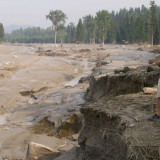
When a tailings pond broke at the Mount Polley gold and copper mine in south-central B.C., spilling millions of cubic metres of waste into a salmon-bearing stream, B.C. Energy and Mines Minister Bill Bennett called it an “extremely rare” occurrence, the first in 40 years for mines operating here.
He failed to mention the 46 “dangerous or unusual occurrences” that B.C’s chief inspector of mines reported at tailings ponds in the province between 2000 and 2012, as well as breaches at non-operating mine sites.
This spill was predictable. Concerns were raised about Mount Polley before the breach. CBC reported that B.C.’s Environment Ministry issued several warnings about the amount of water in the pond to mine owner Imperial Metals.
With 50 mines operating in B.C. — and many others across Canada — we can expect more incidents, unless we reconsider how we’re extracting resources.
Lower-grade mines generating more tailings
Sudden and severe failure is a risk for all large tailings dams — Mount Polley’s waste pond covered about four square kilometres, roughly the size of Vancouver’s Stanley Park. As higher-grade deposits become increasingly scarce, mining companies are opting for lower-grade alternatives that create more tailings. As tailings ponds grow bigger and contain more water and waste than ever before, they also become riskier. The average height of a Canadian tailings dam doubled from 120 metres in the 1960s to 240 metres today. Alberta writer Andrew Nikiforuk likens increasing mining industry risks to those of the oil sands.
Tailings ponds not the best technology
Open ponds of toxic slurry aren’t the best way to manage mining waste. Although there’s no silver-bullet solution, and more research funding on alternative technologies is needed, smaller underground mines are finding safer ways to deal with waste by backfilling tailings.
Drying tailings or turning them to a paste before containment are two other options. Safer solutions cost more, making them less popular with profit-focused corporations. But surely B.C.’s $8-billion mining industry can afford to pay more for public and environmental safety.
Imperial Metals lacks insurance coverage
The government allows the mining industry to choose the cheapest way to deal with waste, and companies often lack adequate insurance to cover cleanup costs when accidents happen. Imperial Metals admits its insurance will likely fall far short of what’s required to repair the damage at Mount Polley.
Weak monitoring and enforcement to blame
The mining industry and provincial and federal governments must do a better job of managing risks. But how can this happen when we’re facing unprecedented dismantling of Canada’s environmental regulations and decreased funding for monitoring and enforcement?
Although the B.C. government rightly appointed an independent panel of three top mining engineers to review the cause of the Mount Polley breach and report back with recommendations, the lack of an environmental or cultural perspective on the panel makes it unlikely we’ll see meaningful industry reform. And even the most thorough reviews remain ineffective without implementation commitments — a point made clear by the federal government’s failure to act on the Cohen Commission’s 75 recommendations on the decline of Fraser River sockeye.
First Nations hold power to confront risky mines
Canada’s mining industry must also work more closely with First Nations, some of which are challenging industrial activity in their territories. The Tahltan blockaded Imperial Metals’ nearly completed mine in the Sacred Headwaters, and the Neskonlith Indian Band issued an eviction notice to an Imperial subsidiary, which proposed an underground lead-and-zinc mine in Secwepemc Territory in the B.C. Interior. With the Supreme Court’s Tsilhqot’in decision affirming First Nations’ rights to land and resources within their traditional territories, we’re likely to see more defending their lands against mining and other resource extractions.
The Mount Polley tailings spill threatens two of B.C.’s most valued resources: salmon and water. As one of the largest sockeye runs enters the waterways to spawn, we must wait to find out the long-term repercussions for Polley Lake, Quesnel Lake and aquatic life further downstream.
This disaster has eroded public trust in the mining industry and regulations governing it. If risks are too high and long-term solutions unavailable or too expensive, the only way to ensure that toxic tailings are kept out of our precious waterways and pristine landscapes may be to avoid mining in some areas altogether.
As the government rallying cry of “world-class safety standards” echoes in our ears, it’s time we lived up to our self-proclaimed reputation.
Written with contributions from David Suzuki Foundation Communications Specialist Jodi Stark.
[signoff3]


This is exactly what I’ve been saying all along. Why we need a more responsible gov’t. that will protect our environment, instead of ruing it.
https://www.change.org/p/the-concerned-citizens-of-british-columbia-ask-for-the-resignation-of-premier-christy-clark#